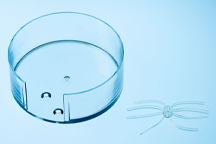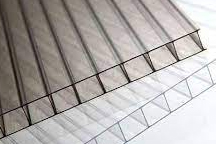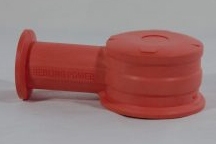Acetal
 Rebling has over 20 years of experience in plastic injection molding both the homopolymer acetal (DELRIN®) and copolymer acetal (CELCON®). This highly versatile material is noted for excellent abrasion resistance and low frictional coefficient which lends itself to applications such as gears, pulleys, bushings, and pumps. Additional features of acetal plastic include excellent creep resistance, high surface hardness, low moisture absorption, and dynamic fatigue resistance.
Rebling has over 20 years of experience in plastic injection molding both the homopolymer acetal (DELRIN®) and copolymer acetal (CELCON®). This highly versatile material is noted for excellent abrasion resistance and low frictional coefficient which lends itself to applications such as gears, pulleys, bushings, and pumps. Additional features of acetal plastic include excellent creep resistance, high surface hardness, low moisture absorption, and dynamic fatigue resistance.
The resistance of acetal thermoplastic material to a broad range of solvents including aliphatic and aromatic hydrocarbons, alcohols, esters, glycols, ketones, detergents, gasoline, and motor oils has resulted in it being the plastic injection molding material of choice for many automotive and plumbing applications. Acetal should not be used if exposure to phenol, aniline, sulfuric acid, hydrochloric acid, and nitric acid is anticipated. The copolymer of acetal (CELCON®) offers improved resistance to very strong bases when compared to the homopolymer version. Acetal is also very notch sensitive, so sharp corners and notches should be avoided when designing for plastic injection molding.
Properties of Acetal
Acetal is a crystalline thermoplastic that maintains a considerable portion of its strength and stiffness at temperatures approaching 200 °F. Rebling has participated in acetal injection molding projects of all kinds. Rebling has, for example, plastic injection molded acetal in a variety of high gloss colors. As with most other thermoplastics, we mold numerous grades of acetal including various concentrations of glass-filled compounds for improved strength and stiffness, impact modified grades, wear resistant grades, ultraviolet resistant grades, and antistatic and electrically conductive grades.
Secondary Operations for Acetal parts
Rebling has provided acetal plastic injection molding components that required post molding operations such as ultrasonic welding, secondary machining operations (including drilling and threading), and cold staking. Rebling routinely molds acetal with machined metal components embedded in the plastic, commonly referred to as insert molding.
Acetal Plastic Injection Molding Design
Due to the high degree of crystallinity in acetal, the shrinkage is not uniform in all material flow directions. This anisotropic shrinkage of acetal makes close tolerance plastic injection molding difficult. Consequently, round parts and features can incur some ovality if not gated correctly, and warpage of flat, thin-walled parts can be troublesome for plastic injection molding. Rebling has employed various gate configurations to minimize these plastic injection problems. As with all thermoplastic materials, part design is crucial in obtaining a functional, aesthetic, and optimum acetal plastic part. The use of ribs, gussets, bosses and other coring techniques should be incorporated into the design so as to maintain a uniform wall thickness. Corner radii should be generous in order to eliminate stress concentration factors. Rebling staff can be contacted regarding design and material specification issues for any plastic injection molded acetal product.


 Thermoplastic
Thermoplastic ABS
ABS Acetal
Acetal Acrylic
Acrylic EMI
EMI Noryl (PPO)
Noryl (PPO) Nylon (Polyamide)
Nylon (Polyamide) Polybutylene Terephtalate (PBT)
Polybutylene Terephtalate (PBT) Polyether Ether Ketone (PEEK)
Polyether Ether Ketone (PEEK) Polycarbonate (PC)
Polycarbonate (PC) Polyethylene (PE)
Polyethylene (PE) Polyphenylene
Polyphenylene Polypropylene (PP)
Polypropylene (PP) Polystyrene (PS)
Polystyrene (PS) Polysulfone (PSU)
Polysulfone (PSU) Thermoplastic Elastomers
Thermoplastic Elastomers UHMW
UHMW Polyetherimide (Ultem)
Polyetherimide (Ultem)